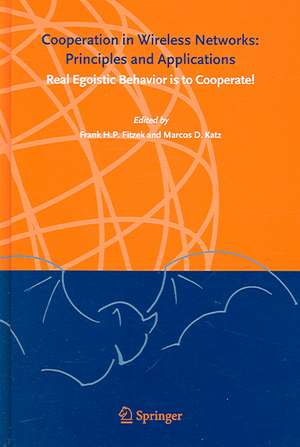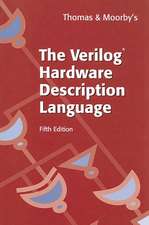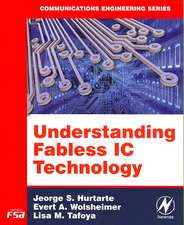Cooperation in Wireless Networks: Principles and Applications: Real Egoistic Behavior is to Cooperate!
Editat de Frank H. P. Fitzek, Marcos D. Katzen Limba Engleză Hardback – 21 apr 2006
| Toate formatele și edițiile | Preț | Express |
|---|---|---|
| Paperback (1) | 963.29 lei 6-8 săpt. | |
| SPRINGER NETHERLANDS – 13 sep 2014 | 963.29 lei 6-8 săpt. | |
| Hardback (1) | 974.81 lei 6-8 săpt. | |
| SPRINGER NETHERLANDS – 21 apr 2006 | 974.81 lei 6-8 săpt. |
Preț: 974.81 lei
Preț vechi: 1188.79 lei
-18% Nou
Puncte Express: 1462
Preț estimativ în valută:
186.55€ • 194.05$ • 154.01£
186.55€ • 194.05$ • 154.01£
Carte tipărită la comandă
Livrare economică 12-26 aprilie
Preluare comenzi: 021 569.72.76
Specificații
ISBN-13: 9781402047107
ISBN-10: 140204710X
Pagini: 696
Ilustrații: LII, 641 p.
Dimensiuni: 155 x 235 x 43 mm
Greutate: 1.29 kg
Ediția:2006
Editura: SPRINGER NETHERLANDS
Colecția Springer
Locul publicării:Dordrecht, Netherlands
ISBN-10: 140204710X
Pagini: 696
Ilustrații: LII, 641 p.
Dimensiuni: 155 x 235 x 43 mm
Greutate: 1.29 kg
Ediția:2006
Editura: SPRINGER NETHERLANDS
Colecția Springer
Locul publicării:Dordrecht, Netherlands
Public țintă
Professional/practitionerCuprins
Cooperation in Nature and Wireless Communications.- Cooperative Communications.- Cooperation, Competition and Cognition in Wireless Networks.- Cooperation Techniques in Cross-layer Design.- Network Coding in Wireless Networks.- Cooperative Diversity.- Cooperation in Ad-Hoc Networks.- Multi-route and Multi-user Diversity.- Cognitive Radio Architecture.- Stability and Security in Wireless Cooperative Networks.- Power Consumption and Spectrum Usage Paradigms in Cooperative Wireless Networks.- Cooperative Antenna Systems.- Distributed Antennas: The Concept of Virtual Antenna Arrays.- Cooperation in 4G Networks.- Cooperative Techniques in the IEEE 802 Wireless Standards: Opportunities and Challenges.- Cooperative Communication with Multiple Description Coding.- Cooperative Header Compression.- Energy Aware Task Allocation in Cooperative Wireless Networks.- Cooperative Coding and Its Application to OFDM Systems.- Cooperative Methods for Spatial Channel Control.
Recenzii
From the reviews
"IEEE Communication Magazine I can wholeheartedly recommend this useful book for postgraduate students, university researchers, and engineers working in the industry. Cooperation in Wireless Networks can not only give insight into this interesting field of research, but also truly inspire its readers to incorporate cooperative designs into their work." (Edited by Andrzej Jajszczyk, Reviewer: Szymon Szott)
"I am confident that this book will stimulate and challenge both the academic and industrial communities in the field of telecommunications, as researchers and groups of engineers investigate, design and implement future wireless communication networks." (John G. Proakis, Northeastern University, USA)
"I went through it and have found it useful in many aspects. Dominating is the impression that the editors have been able to bring together contributions of so many well-known experts in the domain of "cooperation in wireless networks". And that a close to complete coverage of the domain has been reached/achieved.
Some chapters have risen my interest that were not known to me and I spent time to study them and was impressed by the quality of the presentations.
The book is clearly a milestone in its domain, grouping together work of leading experts, presented in well portioned bits for consumption. I will recommend the book to colleagues of mine. Congratulations to the Principal Authors/Editors" (Prof. Dr.-Ing. Bernhard Walke, RWTH Aachen, Germany)
"Future mobile and wireless communication systems will increasingly be based on distributed architecture and cooperation of different network entitites such as network nodes, relay- and/or meshed-based systems, cooperative antennas and cross layer design. This book provides an excellent and extensive overview about the state-of-the-art and the different concepts in this area including detailed lists of references. It is recommended forengineers in the field and for academic courses". (Dr. Werner Mohr, Siemens, Germany)
"Cooperation has been considered as a promising technique for efficient use of resources, decreasing duplications, and enhancing the quality in many disciplines. It is now gaining ground within the wireless communications community. Telecommunications service providers in the wired world found a long time ago that cooperation is a more efficient means of cost saving and providing service in regions of other service providers than traditional individualism. In many cases renting equipment, copper lines, and satellite channels to provide service to customers outside the normal coverage area of a service provider is a much easier and more feasible alternative to expanding the network. Cooperation among national service providers in different countries to provide a complete grid of international coverage is another example of cooperative activity.
Along with recent advances in wireless communications technologies and the emergence of a plethora of different systems, such as cellular and noncellular architectures, infrastructure-based and infrastructureless, as well as packet-switched and circuit-switched, the need for cooperation among wireless systems is becoming more apparent. The use of frequency spectrum and the fact that some systems share the same spectrum with other systems accelerate such need. Additionally, the growth in number of mobile users, the variety of their applications, and the need for diverse contents from many different providers further urge a cooperative network of multiple systems.
This book is one of the first to explore this new trend in wireless systems. In a highly organized and logical way, Frank Fitzek and Marcos Katz succeed in putting together the essential concepts and applications of cooperative wireless communications in 20 chapters. In the first chapter the editors provide some examples of cooperation in nature and how that could motivate cooperation in wireless systems. Cooperation is classified into implicit, explicit macro, and explicit micro cooperation, and design rules for cooperative wireless networks are summarized.
Fundamental limits and practical implementation of cooperative communications are the subjects of the second chapter, where the relay channel is considered as the starting point of cooperation on a larger scale. The third chapter addresses the three paradigms for nodes or clusters of a wireless network operating on the same frequency: competition, cooperation, and cognitive radio transmission. A thorough analysis of cooperative diversity and cognitive radio is provided here. One of the main sources of cooperation is found in cross-layer design, which is the subject of Chapter 4. The next chapter provides a survey of network coding techniques in wireless networks for efficient operation. Chapter 6 discusses cooperative diversity, which allows radio terminals that relay signals to emulate an antenna array and exploit spatial diversity in wireless fading channels. Cooperation in wireless ad hoc networks and multihop networks is the subject of Chapter 7, where the authors show performance limitations of cooperative ad hoc networks. Chapter 8 reviews multiroute and multiuser diversity in infrastructure-based multihop networks. Cooperation induced multiuser diversity relaying is proposed to overcome the fundamental limitations on average achieved throughput per user. The concept of cognitive radio architecture in centralized and ad hoc networks is detailed in Chapter 9, which is said to be significant for establishing a cooperating platform of environment-aware nodes. Accountability and incentives are discussed in the next chapter, which is devoted to stability and security of cooperative wireless networks.
Chapter 11 discusses power consumption and spectrum usage in cooperative wireless networks. This chapter also refers to Chapters 14 and 18, where the importanceof the control of power consumption in future terminals and task splitting in cooperative networks are addressed, respectively. The purpose of this chapter is to show the ways to reduce power consumption in the receiving process of multicast services. A cooperative antenna system is the subject of Chapter 12. Different application scenarios and measurements are shown. The concept of virtual antenna arrays is given in the next chapter. Cooperation in next-generation mobile networks and, more important, in heterogeneous wireless environments is discussed in Chapter 14. Opportunities for cooperation in such networks are addressed after defining the concept of 4G networks. Cooperative techniques for the commonly used IEEE 802 standards are the subject of Chapter 15, where opportunities and challenges of these techniques are addressed. Multiple descriptive coding is introduced in Chapter 16. Discussion on its application to support cooperative communications is given in the same chapter. With a slightly different topic, Chapter 17 presents cooperative header compression for higher bandwidth savings in cellular, local, and multihop networks. Chapter 18 goes back to the topic of energy consumption in cooperative wireless networks; energy models are proposed for computational and communicating components. Orthogonal frequency-division multiplexing (OFDM) with cooperative coding is the subject of Chapter 19. Finally, the last chapter discusses cooperative methods of spatial channel control in indoor and outdoor scenarios.
The contributors to this book are carefully selected from different parts of the world, from both academia and industry. This gives the book good diversity in topics and points of views. It should be useful for a wide group of researchers. Through its chapters, the book covers all aspects of cooperative networks at every layer of the OSI model. The book therefore provides good coverage of all aspects of cooperative wireless networks." (Tarik Taleb,IEEE Wireless Communications)
"The contributions from stellar researchers in this up-to-date volume are both insightful and thought-provoking, and will provide inspiration for exciting, ground-breaking advances in wireless networking." (Martin Reisslein, Associate Professor, Arizona State University)
"This book discusses many important concepts in the field of cooperative communications. It provides detailed information on cooperative wireless network application, such as in the upcoming mobile communication system (4G networks), and emphasizes the application of cooperative technology in this field. The authors have already done a lot of research work in 4G—802.11 protocol as well as in the ad hoc network. It’s undoubtedly a good beginning. I hope that, in the near future, cooperative wireless communications could be applied to land mobile communication.
Practice tells us that wireless communication on the fading channel cannot be satisfactorily accomplished via a diversity technology. Hence, cooperative wireless network technology is a good solution. For example, in a wireless system, the application of space division technology, which expands the channel capacity, is widely recognized. However, in practice, it is hard to implement due to movable physical terminations.
Based on spatial diversity cooperation technology, spatial diversity can be realized by forming a hypothesized multi-antenna system between mobile terminations." (Wang Chengshu <wangcs2003@yahoo.com>, Beijing University of Post & Telecommunication, Beijing, China)
"IEEE Communication Magazine I can wholeheartedly recommend this useful book for postgraduate students, university researchers, and engineers working in the industry. Cooperation in Wireless Networks can not only give insight into this interesting field of research, but also truly inspire its readers to incorporate cooperative designs into their work." (Edited by Andrzej Jajszczyk, Reviewer: Szymon Szott)
"I am confident that this book will stimulate and challenge both the academic and industrial communities in the field of telecommunications, as researchers and groups of engineers investigate, design and implement future wireless communication networks." (John G. Proakis, Northeastern University, USA)
"I went through it and have found it useful in many aspects. Dominating is the impression that the editors have been able to bring together contributions of so many well-known experts in the domain of "cooperation in wireless networks". And that a close to complete coverage of the domain has been reached/achieved.
Some chapters have risen my interest that were not known to me and I spent time to study them and was impressed by the quality of the presentations.
The book is clearly a milestone in its domain, grouping together work of leading experts, presented in well portioned bits for consumption. I will recommend the book to colleagues of mine. Congratulations to the Principal Authors/Editors" (Prof. Dr.-Ing. Bernhard Walke, RWTH Aachen, Germany)
"Future mobile and wireless communication systems will increasingly be based on distributed architecture and cooperation of different network entitites such as network nodes, relay- and/or meshed-based systems, cooperative antennas and cross layer design. This book provides an excellent and extensive overview about the state-of-the-art and the different concepts in this area including detailed lists of references. It is recommended forengineers in the field and for academic courses". (Dr. Werner Mohr, Siemens, Germany)
"Cooperation has been considered as a promising technique for efficient use of resources, decreasing duplications, and enhancing the quality in many disciplines. It is now gaining ground within the wireless communications community. Telecommunications service providers in the wired world found a long time ago that cooperation is a more efficient means of cost saving and providing service in regions of other service providers than traditional individualism. In many cases renting equipment, copper lines, and satellite channels to provide service to customers outside the normal coverage area of a service provider is a much easier and more feasible alternative to expanding the network. Cooperation among national service providers in different countries to provide a complete grid of international coverage is another example of cooperative activity.
Along with recent advances in wireless communications technologies and the emergence of a plethora of different systems, such as cellular and noncellular architectures, infrastructure-based and infrastructureless, as well as packet-switched and circuit-switched, the need for cooperation among wireless systems is becoming more apparent. The use of frequency spectrum and the fact that some systems share the same spectrum with other systems accelerate such need. Additionally, the growth in number of mobile users, the variety of their applications, and the need for diverse contents from many different providers further urge a cooperative network of multiple systems.
This book is one of the first to explore this new trend in wireless systems. In a highly organized and logical way, Frank Fitzek and Marcos Katz succeed in putting together the essential concepts and applications of cooperative wireless communications in 20 chapters. In the first chapter the editors provide some examples of cooperation in nature and how that could motivate cooperation in wireless systems. Cooperation is classified into implicit, explicit macro, and explicit micro cooperation, and design rules for cooperative wireless networks are summarized.
Fundamental limits and practical implementation of cooperative communications are the subjects of the second chapter, where the relay channel is considered as the starting point of cooperation on a larger scale. The third chapter addresses the three paradigms for nodes or clusters of a wireless network operating on the same frequency: competition, cooperation, and cognitive radio transmission. A thorough analysis of cooperative diversity and cognitive radio is provided here. One of the main sources of cooperation is found in cross-layer design, which is the subject of Chapter 4. The next chapter provides a survey of network coding techniques in wireless networks for efficient operation. Chapter 6 discusses cooperative diversity, which allows radio terminals that relay signals to emulate an antenna array and exploit spatial diversity in wireless fading channels. Cooperation in wireless ad hoc networks and multihop networks is the subject of Chapter 7, where the authors show performance limitations of cooperative ad hoc networks. Chapter 8 reviews multiroute and multiuser diversity in infrastructure-based multihop networks. Cooperation induced multiuser diversity relaying is proposed to overcome the fundamental limitations on average achieved throughput per user. The concept of cognitive radio architecture in centralized and ad hoc networks is detailed in Chapter 9, which is said to be significant for establishing a cooperating platform of environment-aware nodes. Accountability and incentives are discussed in the next chapter, which is devoted to stability and security of cooperative wireless networks.
Chapter 11 discusses power consumption and spectrum usage in cooperative wireless networks. This chapter also refers to Chapters 14 and 18, where the importanceof the control of power consumption in future terminals and task splitting in cooperative networks are addressed, respectively. The purpose of this chapter is to show the ways to reduce power consumption in the receiving process of multicast services. A cooperative antenna system is the subject of Chapter 12. Different application scenarios and measurements are shown. The concept of virtual antenna arrays is given in the next chapter. Cooperation in next-generation mobile networks and, more important, in heterogeneous wireless environments is discussed in Chapter 14. Opportunities for cooperation in such networks are addressed after defining the concept of 4G networks. Cooperative techniques for the commonly used IEEE 802 standards are the subject of Chapter 15, where opportunities and challenges of these techniques are addressed. Multiple descriptive coding is introduced in Chapter 16. Discussion on its application to support cooperative communications is given in the same chapter. With a slightly different topic, Chapter 17 presents cooperative header compression for higher bandwidth savings in cellular, local, and multihop networks. Chapter 18 goes back to the topic of energy consumption in cooperative wireless networks; energy models are proposed for computational and communicating components. Orthogonal frequency-division multiplexing (OFDM) with cooperative coding is the subject of Chapter 19. Finally, the last chapter discusses cooperative methods of spatial channel control in indoor and outdoor scenarios.
The contributors to this book are carefully selected from different parts of the world, from both academia and industry. This gives the book good diversity in topics and points of views. It should be useful for a wide group of researchers. Through its chapters, the book covers all aspects of cooperative networks at every layer of the OSI model. The book therefore provides good coverage of all aspects of cooperative wireless networks." (Tarik Taleb,IEEE Wireless Communications)
"The contributions from stellar researchers in this up-to-date volume are both insightful and thought-provoking, and will provide inspiration for exciting, ground-breaking advances in wireless networking." (Martin Reisslein, Associate Professor, Arizona State University)
"This book discusses many important concepts in the field of cooperative communications. It provides detailed information on cooperative wireless network application, such as in the upcoming mobile communication system (4G networks), and emphasizes the application of cooperative technology in this field. The authors have already done a lot of research work in 4G—802.11 protocol as well as in the ad hoc network. It’s undoubtedly a good beginning. I hope that, in the near future, cooperative wireless communications could be applied to land mobile communication.
Practice tells us that wireless communication on the fading channel cannot be satisfactorily accomplished via a diversity technology. Hence, cooperative wireless network technology is a good solution. For example, in a wireless system, the application of space division technology, which expands the channel capacity, is widely recognized. However, in practice, it is hard to implement due to movable physical terminations.
Based on spatial diversity cooperation technology, spatial diversity can be realized by forming a hypothesized multi-antenna system between mobile terminations." (Wang Chengshu <wangcs2003@yahoo.com>, Beijing University of Post & Telecommunication, Beijing, China)
Notă biografică
Frank H. P. Fitzek is an Associate Professor in the Department of Communication Technology, University of Aalborg, Denmark heading the Future Vision group. His current research interests are in the areas of 4G wireless communication networks, cross layer protocol design and cooperative networking.
Dr. Fitzek received his diploma (Dipl.-Ing.) degree in electrical engineering from the University of Technology - Rheinisch-Westfälische Technische Hochschule (RWTH) - Aachen, Germany, in 1997 and his Ph.D. (Dr.-Ing.) in Electrical Engineering from the Technical University Berlin, Germany in 2002 for quality of service support in wireless CDMA networks. As a visiting student at the Arizona State University he conducted research in the field of video services over wireless networks. He co-founded the start-up company acticom GmbH in Berlin in 1999. In 2002 he was Adjunct Professor at the University of Ferrara, Italy giving lectures on wireless communications and conducting research on multi-hop networks. In 2005 he won the YRP award for the work on MIMO MDC.
Dr. Fitzek received his diploma (Dipl.-Ing.) degree in electrical engineering from the University of Technology - Rheinisch-Westfälische Technische Hochschule (RWTH) - Aachen, Germany, in 1997 and his Ph.D. (Dr.-Ing.) in Electrical Engineering from the Technical University Berlin, Germany in 2002 for quality of service support in wireless CDMA networks. As a visiting student at the Arizona State University he conducted research in the field of video services over wireless networks. He co-founded the start-up company acticom GmbH in Berlin in 1999. In 2002 he was Adjunct Professor at the University of Ferrara, Italy giving lectures on wireless communications and conducting research on multi-hop networks. In 2005 he won the YRP award for the work on MIMO MDC.
Caracteristici
First book to address Cooperation in Wireless Networks First class authors offering their best research fields Compendium in Cooperation in Wireless Networks, wide and deep coverage Good balance between theory and practical issues The fastest emerging topic in wireless communications, becoming a real hot-topic Includes supplementary material: sn.pub/extras
















